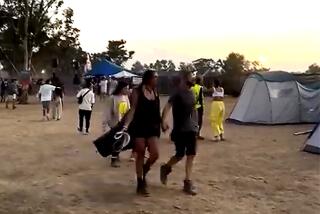Review: Mark Morris mines the Beatles’ ‘Sgt. Pepper’ for an irresistible ‘Pepperland’
From Carlsbad to Santa Barbara, the Southern California coast is peppered with pepper — Pepperland Recording Studios, Pepperdine University, Pepper Lane in Montecito, the Pepper Tree Inn in Santa Barbara just up the road from the Granada Theatre, where choreographer Mark Morris’ “Pepperland” had its California premiere Thursday night.
An eveninglong dance program based on parts of “Sgt. Pepper’s Lonely Hearts Club Band,” “Pepperland,” of course, felt very much like it belonged. Indeed, in an extraordinary nod to California, Morris even found a way to pepper George Harrison’s Indian raga-inspired “Within You Without You” with an Indonesian gamelan lick in the style of the late Californian maverick composer Lou Harrison.
The dance was originally commissioned by the city of Liverpool, to celebrate the 50th anniversary of the release of the Beatles’ historic album, along with a host of other international presenters, including UC Santa Barbara’s Arts & Lectures series. For the next couple of years, it will tour the world. Or maybe even across the universe. It’s that dazzling. (Upcoming local performances will be at the San Diego Civic Theatre on Saturday, and at the Segerstrom Center for the Arts in Costa Mesa in June 2019.)
So here comes some of what’s new under the Beatles sun. The visionary German composer Karlheinz Stockhausen, who happens to be among the notable figures who found their way onto the legendary album cover collage, is introduced as a female dancer in DayGlo turquoise and purple.
“A Day in the Life” begins as an otherworldly theremin solo with a cocktail lounge piano accompaniment. Morris’ frisky dancers mimic every single instance of “Penny Lane” with choreography of such dazzling fast-forward quickness you can’t catch half of it.
I would suggest that the most astounding achievement of “Sgt. Pepper” is not that it invented the concept album, now a dated concept in the age of streaming songs and making your own playlists. Nor is it that this is the first great pop album — meant to be, like electronic music, studio-made, not composed of songs intended for live performance. The difference is like that of film and the stage, but obviously “Sgt. Pepper” is, in the end, performable.
Instead, the great advance of “Sgt. Pepper” was the Beatles’ genius for contrasting provincially comfy old Liverpool with the mod rockers of the late 1960s as well as the psychedelic visions of unseen, unimaginable other worlds. No pop record of the past, and none of such significance since, had its musical range, from music hall sentimentality to Bach to Ravi Shankar to the avant-garde of Stockhausen, John Cage and Luciano Berio.
The look of “Pepperland” — Elizabeth Kurtman’s mod costumes are as bright as neon, with vividly clashing colors and patterns — is not so surprising, nor is Morris’ playful choreography. That’s the popular side of Morris, such as in his hit “The Hard Nut.” But every single move in the dance is, while being utterly musical, entirely unexpected. What first seems wrong always feels right, as though, to confirm John Lennon’s lyric, “Nothing real, but nothing to get hung about.”
The music includes “Sgt. Pepper,” “With a Little Help From My Friends,” “When I’m Sixty Four” and “A Day in the Life,” along with “Penny Lane.” But other music comes from the jazz pianist Ethan Iverson, a longtime Morris collaborator, writing for a mixed band that includes soprano sax, trombone, harpsichord, percussion and theremin. Baritone Clinton Curtis, who traipses between the classical and pop worlds, adds cool, uninflected lyrics.
The rest of the hourlong score is made up of Iverson numbers meant to reflect on aspects of the songs, say a riff on Bach (the trumpet solo in “Penny Lane” having been inspired by the second “Brandenburg” Concerto) with bravura piano and harpsichord runs, or extending a bluesy guitar lick here, the album’s opening chord extended there. One number is meant to introduce some of the characters on the cover.
Nothing sounds like “Sgt. Pepper.” Nothing looks like “Sgt. Pepper” either. Some dances have a theme. Some don’t. Dancers simply have a ball in chorus line routines. Small psychodramas play out with couples and threesomes but not exactly as narrative to the songs, except in “A Day in the Life,” which is done as an instrumental.
Few dances end where they start. Morris and Iverson are masters of the fake-out in general and the false ending in particular. Morris continually plays around with the Beatles’ own contrasts between sentiment and abstraction and sheer fantasy, although he throws in an extra helping of irony now and then.
There is also an overall mood of flippancy (of which Morris is also an amusing master) that turns out not to be flippancy at all but a deep investigation in the way movement tells us who we are.
Ultimately Morris’ is the gift of life, as when a mindless meditating hippie sits cross-legged on the floor, while the rest of the company grooves around him in “Within You Without You,” until he finally rises, not enlightened, just alive.
Nor is “Pepperland” sheer joy, although you can be deceived into thinking it is. It can be so much bouncy fun, especially in Morris’ brilliantly animated big ensemble numbers, untouched by cliché.
But the lonely bits remain in the memory too, the way solo dancers stand apart from the crowd, the way Rob Schwimmer’s desolate theremin solos, Iverson’s torchy piano solos and Curtis’ cheerless vocals could, on their own, comprise a lonely hearts club combo.
“Pepperland” is “Sgt. Pepper” at 50, looking back with irresistible fondness — what fun it all was — but also with wisdom, knowing that it was real and was something to get hung about.
ALSO
Mark Morris’ ‘Dido and Aeneas’ an exuberant spin on ancient epic
Becoming John Luther Adams: The evolution of one of America’s hottest composers
Four radical and radically original pieces of music that blew up the modernist status quo in 1968
A new musical universe at, appropriately enough, Caltech
Music goes multimedia, but why? Three concerts point the way
More to Read
The biggest entertainment stories
Get our big stories about Hollywood, film, television, music, arts, culture and more right in your inbox as soon as they publish.
You may occasionally receive promotional content from the Los Angeles Times.







